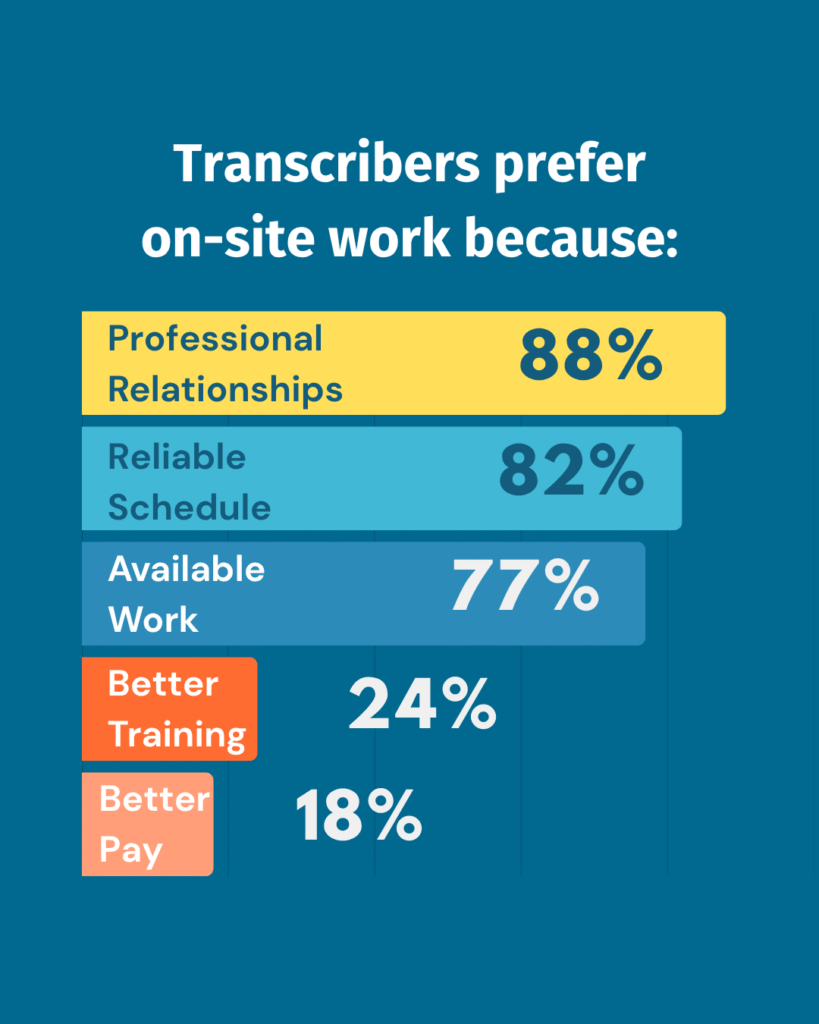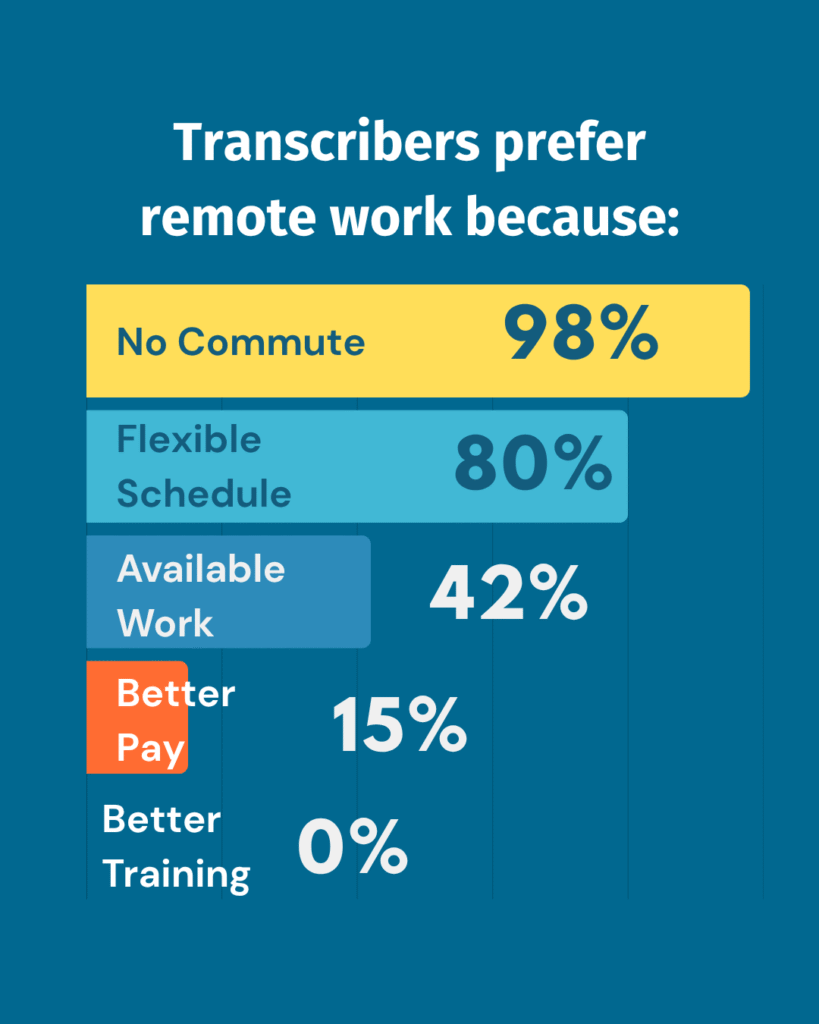When it comes to providing real-time communication access, TypeWell transcribers typically work in one of two ways: on-site or remotely.
- On-site transcribing means the transcriber is physically present in the classroom or meeting room, working alongside the student or client.
- Remote transcribing means the transcriber is working from another location, usually connected through video conferencing tools like Zoom or Google Meet.
Both options help make spoken communication accessible to people who are Deaf or hard of hearing. But which do transcribers prefer, and why?
In Part 1 of our analysis of the 2025 Transcriber Insights Survey, we looked at overall workload trends for TypeWell transcribers: whether they’re getting enough work, what “enough” means, and whether they tend to accept more on-site or remote transcribing assignments.
We found that while remote work remains the most popular choice, transcribers in 2025 are leaning more toward hybrid schedules, taking both remote and on-site jobs when available.

Here’s a snapshot of the survey data:
- While 28% work both on-site and remotely,
35% said they have no strong preference. - While 40% work only remote jobs,
46% say they’d prefer to work remotely exclusively. - While 32% work only on-site jobs,
19% said they’d prefer to work on-site exclusively.
In Part 1, we also reviewed how broader workplace trends and economic pressures are shaping transcriber choices, and we explored how transcribers think about “full-time” and “part-time” work in this field.
Transcribers also elaborated on the different advantages of on-site or remote transcribing. Let’s take a closer look at their responses here.
A closer look at on-site and remote transcribing opportunities
Most TypeWell transcribers are open to taking whatever work is available, as long as it fits their schedule and meets their pay expectations. The shift toward hybrid work—combining both on-site and remote transcribing assignments—is a clear example of this flexibility.
When asked about their preferences, transcribers highlighted different factors that shape their decisions, including career growth, work quality, and lifestyle fit.
What’s drawing transcribers back to campus?
Some transcribers told us there’s just no substitute for being in the room. On-site work provides face-to-face connection, consistent schedules, and better access to professional development.

When we asked why they preferred on-site assignments, transcribers pointed to three main reasons:
- Building professional relationships
“On-site work has allowed me to cultivate valuable professional relationships.” (88% agreed) - More reliable schedules
“On-site work offers a more reliable schedule.” (82% agreed) - More local opportunities
“On-site work is more available in my area.” (77% agreed)
On-site work gives transcribers more chances to develop their skills, connect with the Deaf community, and collaborate directly with teams in the classroom.
What are the top benefits of on-site work?
Many TypeWell transcribers say their work quality is better when they are physically in the classroom or meeting room. Being on-site makes the equipment setup simpler and reduces the chances of technical issues getting in the way.
Here’s why on-site transcribing can be smoother:
- Fewer failure points
Remote transcribers rely on stable internet, video conferencing tools like Zoom or Google Meet, and often need the teacher to use a microphone. If any of these fail, the job can become more difficult or even impossible. On-site transcribers usually just need a laptop. - Direct access to the lecture
Being in the room helps the transcriber hear student comments and see classroom visuals more easily, which leads to more accurate, complete, and context-aware captions. Remote transcribers may need extra equipment or advance preparation to achieve this level of access. - Easier troubleshooting
Remote transcribers can struggle with spotty WiFi or poor audio and may not be able to fix the problem. On-site transcribers can quickly switch seats, plug into Ethernet, or resolve issues on the spot.
Teamwork is better in person
On-site assignments also make it easier to collaborate and communicate with teammates in real time, which can lead to a smoother service experience. One transcriber put it simply:
“I feel the quality of my work is much better when I’m there in person. It’s hard to work with a team who is remote because the audio isn’t always great, and they miss a lot of student comments.”
Some transcribers also said they simply like being out of the house and enjoy the in-person connections with the Deaf community.

More training opportunities on-site
About 24% of transcribers in 2025 said that on-site jobs offer better access to training. For example, Disability Service Coordinators may pay for additional training in Math Mode or Turbo for on-site transcribers. Remote transcribers often have to seek out and pay for those training opportunities on their own.
In fact, no one in our survey said that remote work provided better access to training.
So, why would anyone want to work remotely?
Even though on-site work has clear advantages, remote transcribing is often the more practical option.
For many transcribers, local on-site jobs simply aren’t available or the commute is too long. In those cases, remote work is the only realistic choice.
Despite some of the technical challenges, remote work comes with major benefits that make it appealing: it saves time, reduces costs, and lowers stress.

When we asked transcribers why they prefer remote assignments, here’s what they said:
- Commuting
“Remote work allows me to avoid the time and expense of commuting.” (98% agreed) - Flexibility
“Remote work offers a more flexible schedule.” (81% agreed) - Availability
“Remote work is more available in my area.” (42% agreed)
Remote transcribers have more control
Overall, remote transcribers appreciate the ability to structure their work around other responsibilities and personal needs.
- Saving time and money
Traveling to on-site assignments can be expensive. Freelance transcribers cover their own gas, car maintenance, or bus fares. They also have to consider the opportunity cost of long commutes—time spent in traffic or waiting for public transportation is time they can’t spend on paid assignments. - Balancing other responsibilities
Many transcribers are students, parents, or caregivers who need flexibility to manage school calendars, daycare hours, or family obligations. Some on-site agencies expect transcribers to be available throughout the day, but remote transcribers have more freedom to choose assignments that fit their schedules. - Staying productive during disruptions
On-site transcribers may lose work (and income) if schools close or if they have to stay home with a sick child. Remote transcribers can often keep working in those situations. A few also mentioned that working remotely helps them avoid getting sick themselves. - Better work conditions
Remote transcribers emphasized the importance of improved work-life balance, reduced distractions, and lower physical strain. An on-site transcriber may have to cram herself into a tiny desk in a freezing cold classroom. But working from home allows the transcriber a quiet workspace, a comfortable chair, and an ergonomic setup.
Remote work is hassle free
One transcriber summed it up bluntly:
“On-site work is more hassle and tends to pay less. It also requires professional clothing and trudging through snow. I have no desire to go back.”
Remote transcribing offers a level of control that many transcribers value. It helps them balance work with family, health, and other priorities.

Control comes at a cost
Even with all its benefits, remote work can feel isolating.
“It’s harder to coordinate and connect with teammates when you’re never in the same space, and things fall through the cracks.”
Some transcribers also mentioned that working remotely can lead to miscommunication or a lack of rapport with team members.
Transcriber pay is not a major factor
Surprisingly, pay did not strongly influence whether transcribers preferred on-site or remote work:
- 18% said on-site work pays better
- 15% said remote work pays better
- The rest didn’t notice a significant difference
However, many transcribers did point out that on-site jobs often come with extra benefits, like training or networking opportunities. Nearly a quarter of survey respondents mentioned this advantage—while no one said that remote work provided better access to training.
What do consumers prefer?
No discussion about on-site or remote transcription would be complete without considering the preferences of the people we serve.
In 2024, the Association for Transcribers and Speech to Text Providers (ATSP) conducted a survey of Deaf and hard-of-hearing students who use live captioning services. We covered the results of that survey in our blog post, What Do Deaf People Really Think of AI-Generated Captions?
The survey found that Deaf and hard-of-hearing students prefer on-site transcribers over remote transcribers, especially for classes with a lot of discussion.

When asked about their preferences:
- 26% said they always want on-site services
- 11% said they never want on-site services
When the reverse question was asked:
- 11% said they always want remote services
- 22% said they never want remote services
In other words, twice as many students consistently prefer to receive live captioning services from a transcriber who is in the room. Even with good equipment and a solid WiFi connection, remote transcribers may not catch all the important details that are critical for their clients, such as student comments, side conversations, or background noises that provide context.
There’s no substitute for on-site transcribers, but remote work is still vital
Even with its drawbacks, remote transcription remains vitally necessary.
If 11% of students who are Deaf and hard-of-hearing prefer remote services, then they should have access to them. Remote transcribers play a critical role in making communication accessible, providing flexibility when on-site services aren’t available.
During the COVID-19 pandemic, for example, many high schools and colleges pivoted to online classes almost overnight. Without the quick response from remote transcribers, many Deaf and hard-of-hearing students would have lost access to captioning altogether.
Still, there is a reason we encourage new TypeWell transcribers to start with on-site work before taking remote assignments. On-site experience builds strong professional networks, supports regular training and helps transcribers develop high-quality skills that directly improve their work.
That’s also why many Disability Service Coordinators are bringing transcribers back to campus when possible. The quality of on-site transcription tends to be higher, and it supports stronger connections between transcribers, students, and teams.
Final thoughts
Both on-site and remote transcribing play important roles in providing communication access. Each comes with trade-offs, and transcribers weigh these carefully when deciding which assignments to accept. As technology, workplace expectations, and student preferences continue to evolve, we’ll keep listening to transcribers and the communities they serve.


